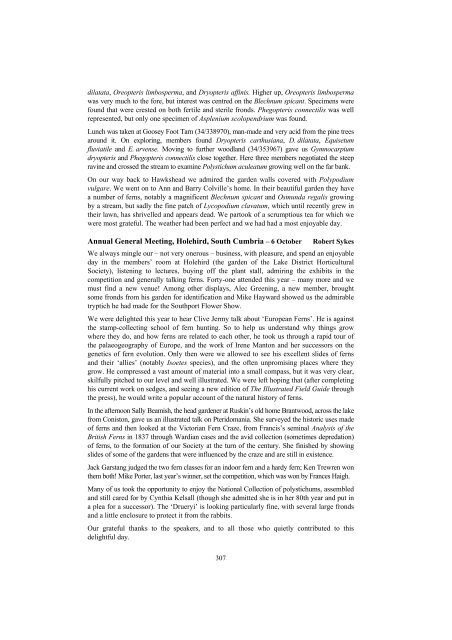REGIONAL MEETINGS - Natural History Museum
REGIONAL MEETINGS - Natural History Museum
REGIONAL MEETINGS - Natural History Museum
You also want an ePaper? Increase the reach of your titles
YUMPU automatically turns print PDFs into web optimized ePapers that Google loves.
dilatata, Oreopteris limbosperma, and Dryopteris affinis. Higher up, Oreopteris limbosperma<br />
was very much to the fore, but interest was centred on the Blechnum spicant. Specimens were<br />
found that were crested on both fertile and sterile fronds. Phegopteris connectilis was well<br />
represented, but only one specimen of Asplenium scolopendrium was found.<br />
Lunch was taken at Goosey Foot Tarn (34/338970), man-made and very acid from the pine trees<br />
around it. On exploring, members found Dryopteris carthusiana, D. dilatata, Equisetum<br />
fluviatile and E. arvense. Moving to further woodland (34/353967) gave us Gymnocarpium<br />
dryopteris and Phegopteris connectilis close together. Here three members negotiated the steep<br />
ravine and crossed the stream to examine Polystichum aculeatum growing well on the far bank.<br />
On our way back to Hawkshead we admired the garden walls covered with Polypodium<br />
vulgare. We went on to Ann and Barry Colville’s home. In their beautiful garden they have<br />
a number of ferns, notably a magnificent Blechnum spicant and Osmunda regalis growing<br />
by a stream, but sadly the fine patch of Lycopodium clavatum, which until recently grew in<br />
their lawn, has shrivelled and appears dead. We partook of a scrumptious tea for which we<br />
were most grateful. The weather had been perfect and we had had a most enjoyable day.<br />
Annual General Meeting, Holehird, South Cumbria – 6 October Robert Sykes<br />
We always mingle our – not very onerous – business, with pleasure, and spend an enjoyable<br />
day in the members’ room at Holehird (the garden of the Lake District Horticultural<br />
Society), listening to lectures, buying off the plant stall, admiring the exhibits in the<br />
competition and generally talking ferns. Forty-one attended this year – many more and we<br />
must find a new venue! Among other displays, Alec Greening, a new member, brought<br />
some fronds from his garden for identification and Mike Hayward showed us the admirable<br />
tryptich he had made for the Southport Flower Show.<br />
We were delighted this year to hear Clive Jermy talk about ‘European Ferns’. He is against<br />
the stamp-collecting school of fern hunting. So to help us understand why things grow<br />
where they do, and how ferns are related to each other, he took us through a rapid tour of<br />
the palaeogeography of Europe, and the work of Irene Manton and her successors on the<br />
genetics of fern evolution. Only then were we allowed to see his excellent slides of ferns<br />
and their ‘allies’ (notably Isoetes species), and the often unpromising places where they<br />
grow. He compressed a vast amount of material into a small compass, but it was very clear,<br />
skilfully pitched to our level and well illustrated. We were left hoping that (after completing<br />
his current work on sedges, and seeing a new edition of The Illustrated Field Guide through<br />
the press), he would write a popular account of the natural history of ferns.<br />
In the afternoon Sally Beamish, the head gardener at Ruskin’s old home Brantwood, across the lake<br />
from Coniston, gave us an illustrated talk on Pteridomania. She surveyed the historic uses made<br />
of ferns and then looked at the Victorian Fern Craze, from Francis’s seminal Analysis of the<br />
British Ferns in 1837 through Wardian cases and the avid collection (sometimes depredation)<br />
of ferns, to the formation of our Society at the turn of the century. She finished by showing<br />
slides of some of the gardens that were influenced by the craze and are still in existence.<br />
Jack Garstang judged the two fern classes for an indoor fern and a hardy fern; Ken Trewren won<br />
them both! Mike Porter, last year’s winner, set the competition, which was won by Frances Haigh.<br />
Many of us took the opportunity to enjoy the National Collection of polystichums, assembled<br />
and still cared for by Cynthia Kelsall (though she admitted she is in her 80th year and put in<br />
a plea for a successor). The ‘Drueryi’ is looking particularly fine, with several large fronds<br />
and a little enclosure to protect it from the rabbits.<br />
Our grateful thanks to the speakers, and to all those who quietly contributed to this<br />
delightful day.<br />
307
















